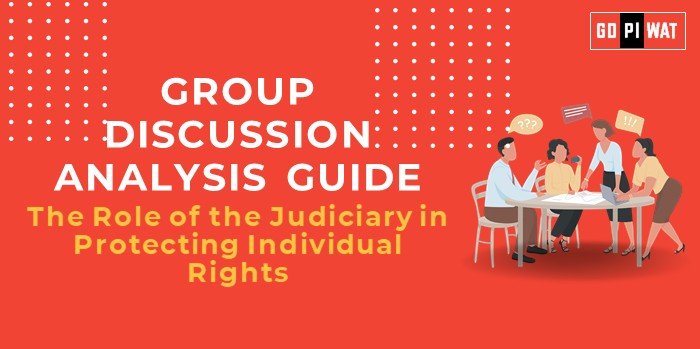📋 Group Discussion (GD) Analysis Guide: The Role of the Judiciary in Protecting Individual Rights
🌐 Introduction to the Role of the Judiciary in Protecting Individual Rights
“The judiciary serves as the sentinel of constitutional rights, ensuring that individuals’ freedoms and liberties are upheld even against the might of the state.”
The judiciary’s role originates from the doctrine of separation of powers, with courts acting as guardians of fundamental rights enshrined in the constitution. Recent landmark judgments worldwide, such as the U.S. Supreme Court’s rulings on abortion rights or India’s decisions on privacy, demonstrate this role’s evolving significance.
📊 Quick Facts and Key Statistics
- Constitutional Rights Coverage: In over 150 countries, constitutional frameworks provide mechanisms for judicial redress on rights violations.
- Case Backlog in India: As of 2024, Indian courts face a backlog of over 4.5 crore cases, complicating timely justice.
- Global Ranking on Justice Systems: Nordic countries lead, while India ranks 69th in the Rule of Law Index 2023.
- Landmark Judgments: Over 75% of landmark human rights cases in India have been decided by the Supreme Court in the last decade.
👥 Stakeholders and Their Roles
- Judiciary: Ensures the interpretation and enforcement of rights.
- Government: Responsible for implementing and respecting judicial decisions.
- Civil Society and NGOs: Advocate for awareness and monitor rights violations.
- Citizens: Active participants in seeking judicial intervention.
✨ Achievements and Challenges
🏆 Achievements
- Right to Privacy Judgment (2017): Recognized privacy as a fundamental right in India.
- LGBTQ+ Rights: Decriminalization of homosexuality in India and similar advances globally.
- Judicial Activism: Landmark cases have redefined socio-political rights.
⚠️ Challenges
- Judicial Backlog: Cases remain pending for decades, diluting justice.
- Access to Justice: Rural and marginalized communities face systemic barriers.
- Global Comparisons: Countries like Estonia have leveraged technology for faster rights adjudication, highlighting gaps in other systems.
Case Study: The Rohingya refugees’ rights case in India, showcasing the judiciary’s role in balancing individual rights and national security.
🔎 Structured Arguments for Discussion
- Supporting Stance: “The judiciary ensures individual rights are upheld even in politically sensitive matters, as seen in environmental judgments globally.”
- Opposing Stance: “Judicial delays and accessibility issues mean many rights violations go unaddressed in a reasonable timeframe.”
- Balanced Perspective: “While the judiciary plays a pivotal role, it must address systemic issues like delays and technology adoption to remain effective.”
🗨️ Effective Discussion Approaches
- Opening Approaches:
- “With constitutional provisions like the right to life and liberty, the judiciary acts as the ultimate protector against state overreach.”
- “The Indian judiciary’s decision in the Kesavananda Bharati case solidified the doctrine of the basic structure, demonstrating its pivotal role.”
- Counter-Argument Handling:
- Address concerns over judicial overreach by citing examples of successful balance, like India’s Vishaka guidelines for workplace harassment.
📋 Strategic Analysis of Strengths and Weaknesses
- Strengths: Strong constitutional backing, judicial independence, precedence of landmark judgments.
- Weaknesses: Procedural delays, accessibility issues for marginalized groups.
- Opportunities: Technology integration, increased awareness among citizens.
- Threats: Political interference, erosion of public trust.
📚 Connecting with B-School Applications
- Real-World Applications: Legal frameworks’ role in business compliance, human rights issues in corporate governance.
- Sample Interview Questions:
- “How does judicial activism impact economic policies?”
- “Discuss a landmark case and its implications for business operations.”
- Insights for Students: Research opportunities in public-private legal frameworks, understanding rights in corporate settings.


